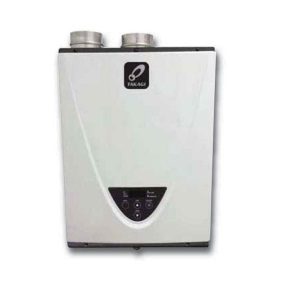- Review
- Best
- Tankless
- Tank-type
- Heat Pumps (Hybrids)
- RV Water Heaters
- Gas
- Electric
- Pool Heaters
- Solar
- Bosch
- Navien
- Noritz
- Paloma
- Rinnai
- Takagi
- American
- AO Smith
- Bradford White
- GE
- John Wood
- Reliance
- Rheem
- Richmond
- Ruud
- State
- US Craftmaster
- Hydronic Heating
- Troubleshooting
- Maintenance
- Parts
- Sitemap
- What's New
- About me
- Contact me
- Privacy
- Disclaimer
Benefits of Tankless Water Heaters
Are Tankless Heaters Worth the Investment?
(If you purchase a product or service through links on this page, I receive a small commission at no cost to you as an Amazon Associate/affiliate).

Explore the benefits of tankless water heaters, including drawbacks, to see if they are worth the investment.
See how tankless compares to conventional tank-type models and use pros and cons to decide whether to switch or not.
Need professional help with your water heater?
Get free quotes today!
Top 15 tankless water heaters benefits that will make the difference in your comfort
Tankless water heaters, also known as on-demand heaters, are modern, small, powerful, and efficient.
They have many advantages over tank-type, but also disadvantages.
As you go through the listed tankless pros and cons, you will be able to answer the question "which one is better, tankless or tank-type," and make the right choice.
Tankless water heaters are small and lightweight
With the tankless and on-demand water heating, no more bulky storage water tanks that occupy much of the floor space.
Tankless are designed small; they come in the size of a small suitcase (some models are only 10" X 20" X 30") and can weigh from 30 to 70 pounds, which allows easy transport, handling, and wall installation, leaving the floor space free for other use.
Buy the Best of Rinnai
Tankless heats water on demand
As opposed to tank-type water heaters that heat and store water even when it is not needed, tankless use the heat exchanger to heat water only when required - on-demand. This is what makes them very efficient, putting less stress on the components and providing fresh and clean hot water for less.
Tankless delivers hot water in an endless supply
While tank-type heaters have a limited capacity to store hot water (usually from 20 to 100 gallons), tankless can deliver hot water in endless supply, as long as there are water, gas, and electric supply.
Tankless can save more energy
According to the US Department of Energy, tankless can save up to 50% more than tank-type. The maximum energy efficiency of the gas tankless type is found on Navien, Rinnai, and Noritz and can reach up to 98% efficiency rate.
Tankless are eligible for rebates and tax credits
It is proven that tankless water heaters could save over 40% on the gas bill, while those that utilize the condensing technology are known as ultra-efficient, providing even more savings to their owners. If you are buying a new unit, check if they are eligible for your local utility company saving programs and federal tax credits, which help offset high purchase costs.
Tankless are “green” or eco-friendly
Most tankless water heaters are equipped with eco-friendly gas burners, which allows them to reduce the emission of green gases significantly.
Variety of models available
There are many types of tankless available; gas-powered and electric operated types, condensing and non-condensing, point-of-use or whole-house, power-vent, or direct-vent.
Variety of brands available
While the North American market is already familiar with the top three domestic brands; AO Smith, Bradford White, and Rheem, there are also some of the imported brands that are truly amazing and being present on the market for many years: Rinnai, Takagi, and Noritz.
Easy maintenance
While tank-type often needs draining, flushing, and emptying the large storage tanks due to bad odor, deteriorated anode rod, or sediment build-up, tankless are much easier to maintain, which mostly includes cleaning the parts and occasional flushing. If the water is not hard, you could go without maintenance for a few years.
Tankless provides flexible installation
Depending on the model, tankless can be installed indoors or outdoors, while tank-type cannot. The venting options (horizontal and vertical termination, power, and direct venting) and pipe lengths are what give more flexibility to the user.
Tankless water heaters are designed with the advanced components
- Electronic control board: It allows programming, computer monitoring, control, and diagnostics.
- Recirculation system: It will enable faster water delivery.
- Advanced electronics: It makes the heaters smart as they can use Wi-Fi and voice recognition technology, including a home management system.
- Electronic ignition: It replaces old pilot lighting for better flame control, reliable operation, and long work.
- Tankless is equipped with several sensors for safety, efficiency, and reliable work.
- The remote controller brings convenience so that users can have better comfort.
- Modulating gas control valve and power makes water heating efficient, so only needed power is used for the current water flow and demand.
Cascading option available for more power and water flow
Some manufacturers provide an option to connect two or more units into one system and therefore provide more power and water flow. This is what makes tankless ideal for high-demanding applications or homes. This is how you will have an unlimited hot water supply to multiple showers and appliances simultaneously.
Tankless are safe
While they are equipped with many safety features, tankless is not as prone to leaking, corrosion, and rotten egg smell, as the tank-type.
Less waste onto the landfills
Every component inside the tankless water heaters can be replaced, which extends the life of a heater, so you don't have to buy a new one every 10 years or so. In the case of the tank-type heaters, some components cannot be replaced (storage tank, for example), so you have to replace them.
Longer life and better warranties
Most manufacturers provide warranties of 12 to 15 years on the heat exchangers and up to 5 years on other tankless components, while the life expectancy is over 20 years. Tank-type heaters have the longest warranty of 12 years, and the life expectancy is approximately 10-15 years.
Adds value to your home, making them a great investment
Tankless water heaters can increase the home resale value as they are modern, safe, save on energy, are green, and have a longer lifespan.
Drawbacks
- High purchase price and installation costs.
- Water temperature can fluctuate, making an unpleasant "cold water sandwich" effect.
- They cannot deliver water during a power outage.
- Tankless cannot start if the minimum required water flow is not met.
- They are powerful but also require a lot of energy.
Conclusion
By getting familiar with the benefits of tankless water heaters, choosing the best type and model for your home is now much easier.
Buying a cheaper or low-efficient heater, which can also heat the water, is not always the right choice.
Knowing that one household consumes approximately 20% of the entire home's energy use is not something to neglect. Modern homes are using large bathrooms, hot tubs, whirlpool tubs, and multiple showerheads, so the demand for hot water is rising, and with the higher fuel prices, the expenses are increasing every year, making a significant impact on your wallet.
So, make a smart choice – buy a tankless. If you are looking for the best, get one of these: Rinnai RUR98, Takagi T-H3, or Nortiz NRCP, all of them condensing, ultra-efficient and ultra-low NOx.
Except for the energy and cost-saving benefits, they bring flexibility, reliability, comfort, and durability.
Related articles
Need professional help with your water heater?
Get free quotes today!
- Home
- Tankless water heaters
- Benefits of Tankless Water Heaters


